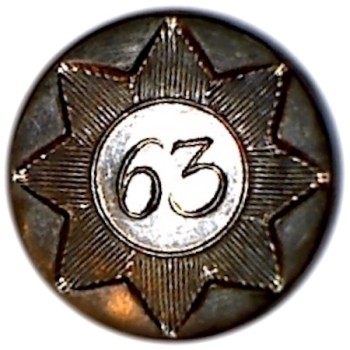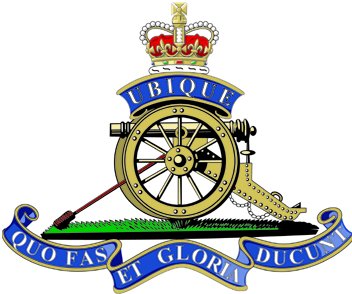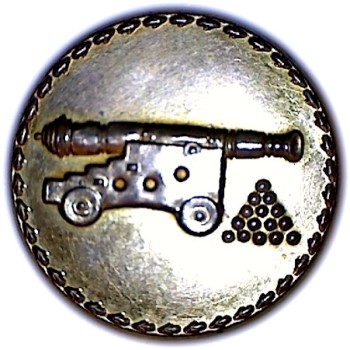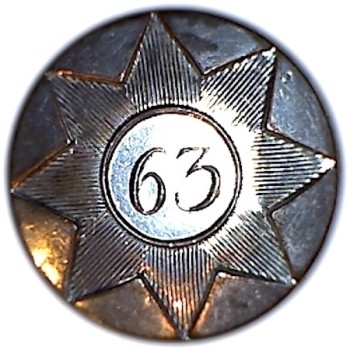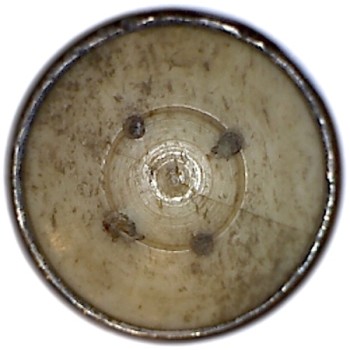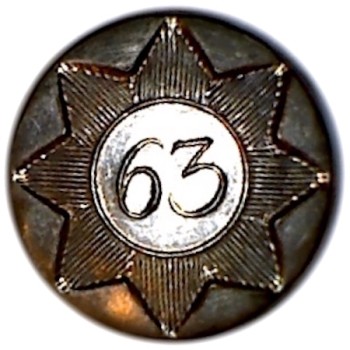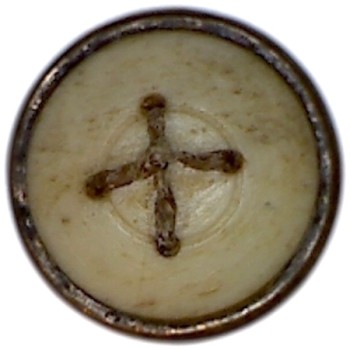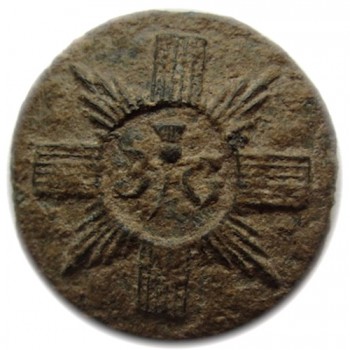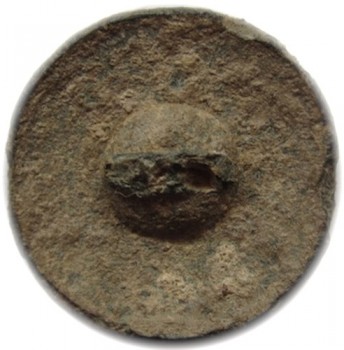The 18th Century British Army
Regt. of Foot
&
Royal Regt. of Artillery
The British Army….
The Royal Regiment of Artillery
1790-1810 THE ROYAL REGIMENT of ARTILLERY
Color: White With Gilt Highlights
Metal: Flat, Raised Design, Gilt Repouse Sheet Copper Wrapped Over Bone Back.
Button Size: Approx. 25mm. Coat Size.
Present Condition: A Non Excavated Specimen, Exceptional Planchet Condition, Exceptional High Relief Pattern Remains.
Robert’s Notes: Dating is uncertain for it’s use. There are also no excavated specimens as of date. This is the large coat size Artillery Officer’s pattern. The button’s pattern depicts a Large Cannon on a Garrison Carriage with a stack of 15 Cannon Balls (or round shot) in front that are stacked in a pyramid shape. The high relief pattern is set on a plain flat field with a raised leaf edge border.
Reverse Attachment: This is a two-piece button with a Bone Back and a Cat Gut Cord for Attachment.
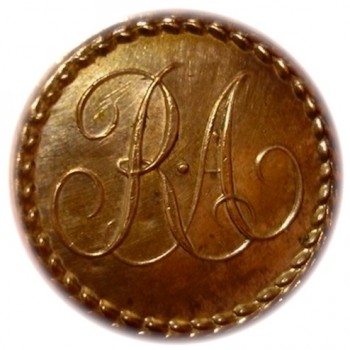
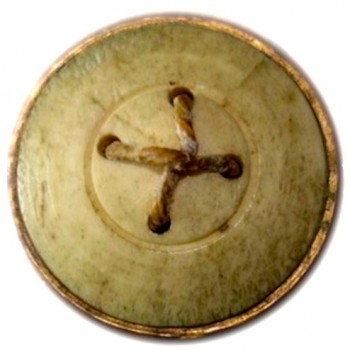
THE HONORABLE EAST INDIA COMPANY
Color: Coppery Orange.
Metal: Flat, Raised Design, Gilt Copper Repousse Wrapped over A Bone Disc.
Button Size: 23mm.
Present Condition: A Non Excavated Specimen, Exceptional Planchet Condition, An Exceptional High Relief Pattern Remains.
Robert’s Comments: This button is not related to any commissioned officers serving the British Army during the American Revolution. There is a portrait of an Officer of the Madres Artillery in 1784, has shown the button to represent the Honorable East India Company. There is also a matching cuff example. The button’s pattern depicts two large script initials, “R . A” in the center thought to mean Royal Artillery. Circling around the legend’s is a raised Leaf Edge trim.The high relief pattern is set on a plain flat field, with a thin raised leaf edge border.
Reverse Button Analysis: This is a 2-piece bone back button with cat gut or heavy thread cord.

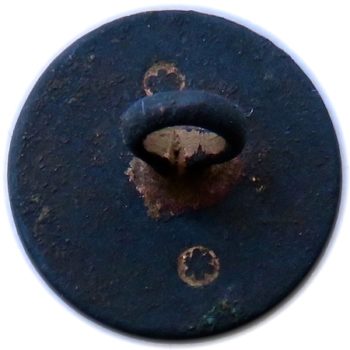
1757-1782 58th Regt. of Foot RutlandShire
Color: Greenish Brown with Gilt Highlights.
Metal: Flat, Impressed Design, Gilt Copper.
Button Size: 17mm. Cuff Size.
Present Condition: An Excavated Specimen, Exceptional Planchet Condition, An Exceptional Impression Remains.
Robert’s Comments: This regiment was originally organized by Colonel Robert Anstruther as the 60th Regt. of Foot in 1755 for service in the 7 year war. It was reorganized as the 58th Regt. of Foot following the disbandment of the existing 50th and 51st regt.’s. The regiment went to North America in the spring of 1758 for the French Indian War campaign and saw action at the siege of Louisbourg in June of 1758, the Battle of the Plains of Abraham in Sept of 1759, and the Battle of Sainte-Foy in April of 1760. Afterward, the regiment disembarked for the West Indies. En route to the West Indies 8 companies of the regiment were captured by the French. the remainder took part in the Battle of Havana in the summer of 1762 during the anglo Spanish War. In 1770, the regiment returned to England and was posted to Gibraltar and saw action in the Great Siege in the early 1780’s. This regiment never took part or saw any service in the American Revolution.
The Robert J. Silverstein Collection.
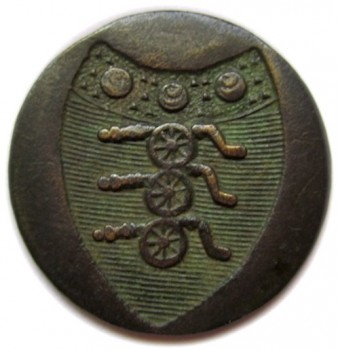
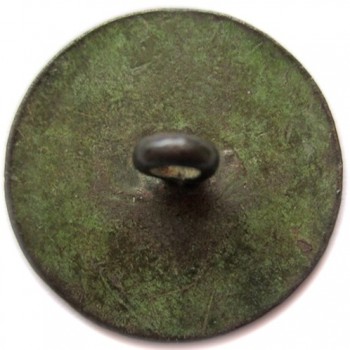
THE ROYAL REGIMENT of ARTILLERY BUTTON (First Seen Post Revolution)
Color: A Brassy Brown with Green Encrustations.
Metal: Flat, 1-Piece, Raised Design, Gilt Brass.
Button Size: 24.87mm.
Present Condition: A Non Excavated Specimen, Exceptional Planchet Condition, Exceptional High Relief Pattern Remains.
Robert’s Notes: During the American Revolution the British Artillery enlisted men mainly wore unmarked (blank) flat brass buttons. Although, from officer’s portraits of the era, we know that there were two types of Officer’s buttons used. This Artillery button’s pattern depicts The Ordnance Arms. The depiction shows Three Stacked Cannons at Rest within a sunken Norman Style Shield. The high relief pattern is set on a evenly spaced lined filed. Above the Cannons is an arc housing Three Round Shots with a pattern of 5 Raised Stipples in-between. The first order fulfillment probably wasn’t until 1783, after the war ended. There have been no battlefields or campsites prior to 1784, that have shown this pattern to be found.
Reverse Button Analysis: This is a one-piece button with a loop shank.
The RJ Silverstein Collection.
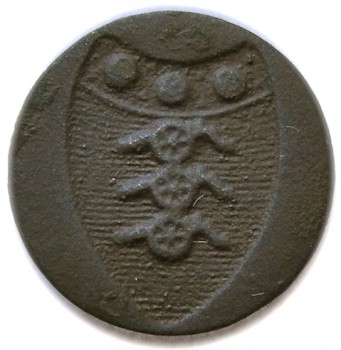
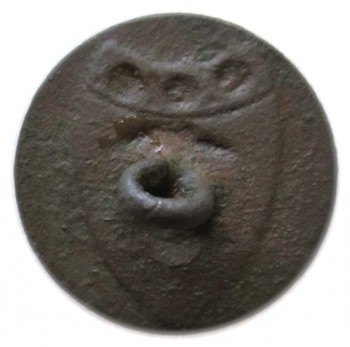
THE ROYAL REGIMENT of ARTILLERY VEST/CUFF BUTTON (Post Revolution)
Color: This has an Olive Brown Patina.
Metal: Flat, 1-Piece, Raised Design, Gilt Brass.
Button Size: 16.81mm. Cuff /Vest Size
Present Condition: An Excavated Example, Good Planchet Condition, Good High Relief Pattern Remains.
Robert’s Comments: This button’s pattern depicts The Ordnance Arms. The depiction shows Three Stacked Cannons at Rest within a sunken Norman Style Shield. The high relief pattern is set on a evenly spaced lined filed. Above the Cannons is an arc housing Three Round Shots with a pattern of 5 Raised Stipples in-between. The first order fulfillment probably wasn’t until 1783, after the war ended. There have been no battlefields or campsites prior to 1784 that have shown this pattern to be found.
Reverse Button Analysis: This is a one-piece button with a loop shank.
The RJ Silverstein Collection.

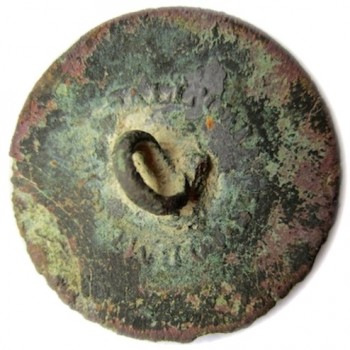
1785-1800 ENGLISH MILITIA ARTILLERY
Color: An Aged Brown Patina with Red Undertones.
Metal: Slightly Convex, 1-Piece, Raised Design, Gilt Brass.
Button Size: 24.81mm.
Present Condition: An Excavated Example, Fair Planchet Condition, Fair High Relief Pattern.
Variation: Sunken Norman Shield / 2 Cannons & Brown Bess In-Between / Artillery.
Robert’s Comments: This is a rare Post-Revolution English Militia Artillery button. Most likely not an officer’s button. This button was most likely worn by someone serving in one of the many militia artillery units stationed in Great Britain / England. Most likely dating around the beginning of the 1800’s. The button’s pattern depicts a sunken Norman Shield with a large British Crown above. Within the shield there are Two Cannons pointing right, with a Brown Bess Style Musket in-between. Inscribed on the left hand-side of the button’s border edge is the word, “ARTILLERY “, in all capital letters. On the right hand-side edge border is the word, “COAST.” The inside high relief motif is set on an evenly lined field within the sunken shield.
Reverse Button Analysis: This is a flat one-piece button with a loop shank.
The RJ Silverstein Collection.
My guess is English Militia , it’s certainly not a regular army artillery button. Probably dug in UK where the unit stayed for it’s entire existence. There was a huge number of UK militia units at the time , all with their own buttons and plates that sat out all the wars . dt
The Royal Irish Artillery, 1785- 1801
The Royal Irish Artillery was originally raised in Dublin, Ireland in 1756 from a Royal Artillery detachment that was stationed there from England. Later, when the American Revolution was in full swing a small detachment was sent to serve with Burgoyne’s expedition in 1777. Otherwise, the Royal Irish Artillery mostly served in the West indies during the 1790’s era. They officially disbanded in 1801.
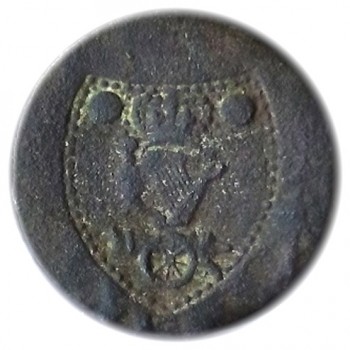
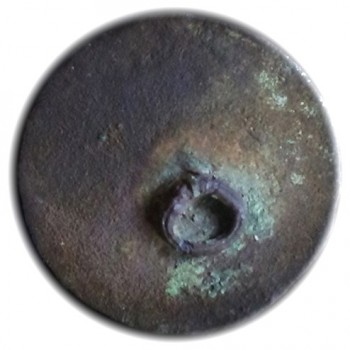
1785-1801 THE ROYAL IRISH ARTILLERY
Color: Charcoal Ash Grey with White Encrustations.
Metal: Flat, 1-Piece, Raised Design, Gilt Brass.
Button Size: 24.21mm. Coat Size
Variation: Dotted Shield Perimeter / Canon Wheel Even with Cannon Top / Modern Cannon.
Present Condition: An Excavated Example, Good Planchet Casting, Good High Relief Pattern.
Robert’s Comments: The button’s pattern depicts a British Royal Crown surmounting an Irish harp that is over a Cannon. The cannon has a short carriage, and the cannon’s wheel is even with the top of the cannon. The small crown has two raised stipples flanking each side. The high relief pattern is set within a sunken Norman Shield that has an evenly lined field. This shield does have the perimeter stipples around the edge border. There are rarer die variants known that do not posses these perimeter stipples.
Reverse Button Analysis: This is a one piece button with a copper loop shank.
The RJ Silverstein Collection.
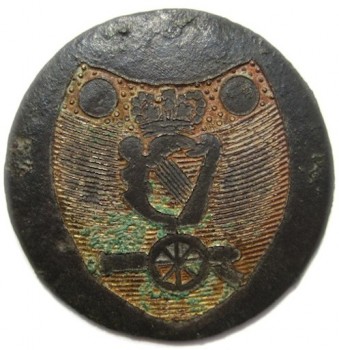

1785-1801 THE ROYAL IRISH ARTILLERY
Color: Aged Brown with Orange & Green Undertones.
Metal: Flat, 1-Piece, Raised Design, Gilt Brass.
Button Size: 23.45mm. Coat Size
Present Condition: An Excavated Example, Good Planchet Condition, Good High Relief Pattern Remains.
Variation: Canon Wheel Extends Past Cannon Top / Old Style Cannon at Rest / Crown Pattern Dotted / No Perimeter Dots.
Robert’s Comments: This is the another die variant that was used by the Royal Irish Artillery. This button’s pattern is slightly different then the other two known examples. This button’s pattern depicts a Large Irish Harp in the Center surmounting a Cannon. Above is a Crown in the center which is flanked by Two Round Shots. The high relief pattern is set within a sunken Norman Shield with an evenly lined field. The Crown and Round Shot is set on a flat field with raised stipples.
Reverse Button Analysis: This is a one piece button with a loop shank.
The RJ Silverstein Collection.
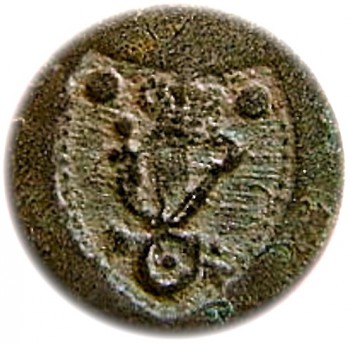
1785-1801 THE ROYAL IRISH ARTILLERY
Color: An Olive Brown Patina.
Metal: Flat, 1-Piece, Raised Design, Cast Gilt Brass.
Button Size: 16.5mm. Cuff /Vest Size.
Present Condition: An Excavated Example, Fair Planchet, Fair High Relief Pattern Remains.
Robert’s Comments: This enlisted man’s button’s pattern depicts a small Crown surmounting a Harp which is above a Cannon. There are two raised Round Shots on each side of the crown with stipples in-between. The high relief pattern is set within a sunken Norman Shield with a raised stipple edge border.
Reverse Button Analysis: This is a one-pice button with a soldered on copper loop shank.
The British Regt. of Foot
Officers & Enlisted men’s Patterns
1775-1782 63rd Regt. of Foot Officer’s Dress
Color: Ice Silver.
Metal: Flat, Raised Design, Silver Sheet Copper Wrapped Over A Bone Disc.
Button Size: Approx. 24.02mm. Coat Size.
Present Condition: A Non Excavated Specimen, Exceptional Planchet Condition, An Exceptional High Relief Pattern Remains.
Robert’s Comments: There appears to be only one pattern for an Officer’s button. It comes in both coat and cuff size. The button’s pattern depicts a large evenly lined crosshatch 8 Pointed Star. In the center is a raised Concentric Ring with an Arabic Regt. number 63 in the middle. The high relief pattern is set on a plain filed.
Reverse Button Analysis: This is a 2-piece with either a 4 or 5 hole bone back. A cat gut or heavy thread cord was used for attachment.
The Joe Cuevas Collection.
1775-1782 63rd Regt. of Foot Officer’s Dress
Color: Tarnished Silver.
Metal: Flat, Raised Design, Silver Sheet Copper Wrapped Over A Bone Disc.
Button Size: Approx. 17mm. Cuff Size.
Present Condition: A Non Excavated Specimen, Exceptional Planchet Condition, An Exceptional High Relief Pattern Remains.
Robert’s Comments: This is the cuff size matching button. The button’s pattern depicts a large crosshatch lined 8 Pointed Star. In the center is a raised Concentric Ring with an Arabic Regt. number 63 in the middle. The high relief pattern is set on a plain filed.
Reverse Button Analysis: This is a 2-piece with either a 4 or 5 hole bone back. A cat gut or heavy thread cord was used for attachment.
The Joe Cuevas Collection.
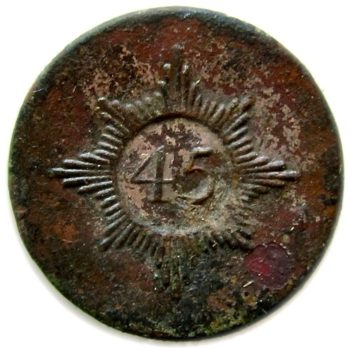
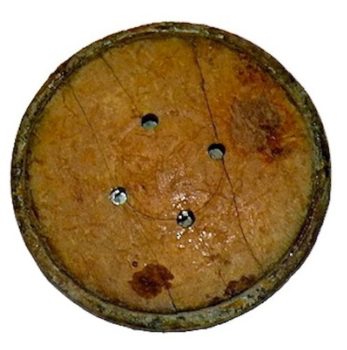
1778-1794 45th Regt. of Foot Officer’s Dress
Color: An Ochre of Reddish Tones and Green W/ Silver Undertones.
Metal: Flat, Raised Design, Silver Sheet Copper Wrapped Over A Bone Disc.
Button Size: 24mm. Coat Size.
Present Condition: An Excavated Specimen, Strong Planchet Condition, A Strong High Relief Pattern Remains.
Robert’s Comments: The 45th Regt. of Foot was a British Army Line infantry regiment which was raised by Colonel Danial Houghton in 1741 for the War of Australia Succession. Originally known as Houghton’s Regiment. The regiment saw action during the Father Le Loutre’s War, the French & Indian War, Peninsular War, the First Anglo Burmese War, the Xhosa Wars, as well as the American Revolution. Busy group!..lol In the American Revolution they saw action in the Battle of Long Island in August of 1776, and had a detachment of a 100 men partake in the Danbury raid. Flank companies were in Philadelphia campaign of 1777, including actions in Germantown and Brandywine. they returned to England in 1778. In 1779, the citizens of Nottinghamshire petitioned for the regiment to have the county name, 1st Nottinghamshire included in their regiment name. In 1786 the regiment embarked for the West Indies and had garrisons in Martinique, Dominica and LLes des Saintes during the French Revolutionary War. Returned back to England in 1794, and in 1795 returned to the West Indies. Being this button was dug in New York, one can only conclude this was not a later date design as inaccurately stated in the two flawed rev war button book guides.
Reverse Button Analysis: This is a 4 sew hole bone back reverse. A cat gut or heavy thread cord was used for attachment.
This Specimen was dug by Alex C. in New York.
The Robert J. Silverstein Collection.
The regiment also saw action in North America during the American War of Independence, fighting at the Battle of Long Island in August 1776[6] before returning to England in 1778.[7] In 1779 the citizens of Nottinghamshire petitioned for the regiment to have the county name included in the regimental name:[8] this was granted and the regiment became the 45th (1st Nottinghamshire) Regiment.[1] In March 1786 the regiment embarked for the West Indies[9] and garrisoned Martinique, Dominica and Îles des Saintes during the French Revolutionary Wars.[10] In May 1801, on the home journey, some 150 French prisoners aboard the ship, the Windsor, overpowered the guard, locked the officers in their cabins and took possession of the ship.[11]

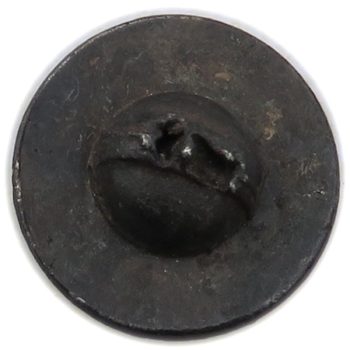
3rd Foot Guards (Scots Guards) 1st Pattern 1767-70’s
Color: A Charcoal Brown.
Metal: Flat, 1-Piece, Raised Design, Gilt Brass W/ Iron shank reverse.
Button Size: 25mm.
Present Condition: An Excavated Example, Strong Planchet Condition, Strong High Relief Pattern Remains.
Robert’s Notes: This pattern was known to have changed three times by 1775. This is the first pattern and dates from 1760 to 1770. This is the large coat button. The button’s pattern depicts a large raised, “Gds over a large 3” in the center. The high relief pattern is set on a plain flat field with a raised Stipple Channel with a small Leaf Pattern within. These officers composed a composite Brigade of Guards with the 1st and 2nd of Foot.
Interesting Facts: There campaigns included the New York in 1776, Philadelphia in 1777, Monmouth Courthouse in 1778, Fort Lafayette on Verplank’s Point in 1779, Fort Tyron, Spring Field, N.J. in 1780, then to Camden, and Guilford Courthouse. The remnants of the brigade was captured at the siege of Yorktown, Virginia. They returned to Great Britain in 1783.
Reverse Button Analysis: The button has a raised Boss with a Iron loop shank missing.
The RJ. Silverstein Collection
3rd Foot Guards (Scots Guards) 3rd Pattern 1775-83
Color: Soil Brown W/ Grey Undertones.
Metal: Flat, 1-Piece, Raised Design, Pewter.
Button Size: 24.36mm.
Coat size.
Present Condition: An Excavated Specimen, Strong Planchet Condition , Strong High Relief Pattern Remains.
Robert’s Notes: This is the third pattern known to be used by the enlisted man. There is also two die variants using this depiction. This button is the large size coat pattern worn by enlisted men during the American Revolution. The button’s pattern shows an Eight Pointed Star representing the union flag of England’s Cross of St. John and Scotland’s St. Andrew’s Cross. The center has a well with a raised Scottish Thistle and is flanked by an Arabic “3” on the left and a “G” on the right.
Interesting Facts: These officers composed a composite Brigade of Guards with the 1st and 2nd of Foot. There campaigns included the New York in 1776, Philadelphia in 1777, Monmouth Courthouse in 1778, Fort Lafayette on Verplank’s Point in 1779, Fort Tyron, Spring Field, N.J. in 1780, then to Camden, and Guilford Courthouse. The remnants of the brigade was captured at the siege of Yorktown, Virginia. They returned to Great Britain in 1783.
Reverse Button Analysis: The button has a raised Boss with a loop shank.
Excavated in New Jersey.
The RJ Silverstein Collection.

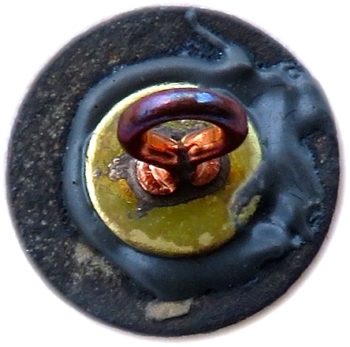
1778-82 55th Regt. of Foot
Color: Silver W/ Green Encrustations.
Metal: Flat, 1-Piece, SilverPlate.
Button Size: 14.02mm.
Cuff Size.
Present Condition: An Excavated Specimen, Good Planchet Condition, A Good Impression Remains.
Robert’s Notes: This is a Silver Plate Sergeants button. The 55th Regt. of Foot was a British Army infantry regt. organized in 1755. The regt. was originally raised in Stirling by Col. George Perry as the 57th Regt. of Foot in 1755 for service in the Seven Year War. It was reorganized as the 55th regt. of foot following the disbandment of the existing 50th and 51st regiments in 1756. The 55th regt. served in America from 1755-1778, and seen action in Brandywine, Germantown, the Battle of Princeton and the New York Campaign. After 1782, the 55th was distinguished with a county designation, and was known as the Westmorland Regt. of Foot.
Reverse Button Analysis: This is a one-piece button with a loop shank. The shank is a later date re-attachment.
The RJ Silverstein Collection.


1751-82 20th Regt. of Foot British Army Line Infantry
Color: Dusty Brown with Dark Silvery Highlights.
Metal: Flat, 1-Piece, Silver plate copper.
Button Size: 23.83mm.
Coat Size.
Present Condition: An Excavated Specimen, Good Planchet Condition, A Good Raised Design Remains.
Robert’s Notes: This regiment war reorganized in 1751, from an older commission to Sir Richard Peyton in 1688. Peyton’s regiment served under King William III of England direction in matters of Scottish Crown rebellion. Peyton’s 20th Regiment saw action in the Glorious Revolution and subsequently during three other Jacobite uprisings. This regiments is often written using the Roman numerals “XX” which led to an unofficial nickname, “The Two Tens.” During the Seven Year War the regiment earned honor in august of 1759 at the Battle of Minden. The 20th received new orders and was sent to Quebec Canada in May of 1776. They were noted in this service by standing fast and breaking-up a French Cavalry charge. During the American Revolution the 20th served under General John Burgoyne for the remainder of the Canadian campaign. In 1776, they participated in the Carlton Expedition on Lake Champlain, including action on Valcour Island. They saw action at Freemans Farm and were present under General Burgoyne command during the surrender of Saratoga. Elements of the regiment remained in Canada afterwards serving in various posts. they finally returned to Halifax in 1789. Prior in 1782, they were officially designated the “East Devonshire” regiment.
Reverse Button Analysis: This is a one-piece button with a loop shank. The shank is a later date re-attachment.
Picture Courteous of Ian Workman

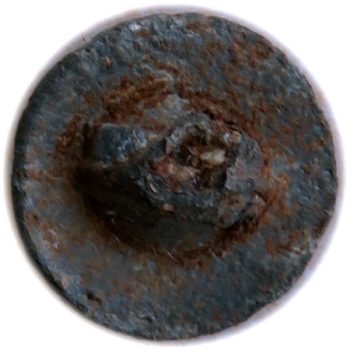
1778-1788 74th Regt. of Foot Argyllshire Highlanders
Color: Charcoal with Orange Freckles.
Metal: Flat, Raised Design, Led.
Button Size: 17mm. Cuff Size.
Present Condition: An Excavated Specimen, Poor Planchet Condition, A Poor High Relief Pattern Remains.
Robert’s Comments: The 74th Highland Regt. was a British Army Line Regiment from 1777 to 1784 which was specifically raised to fight in the American Revolution. John Campbell of Barbreck received letters of service from King George III to raise a regiment of infantry in the county of Argyll. The regiments flank companies joined the main British Army in the city of New York in the spring of 1779. The remaining regiments went to Bagaduce in Massachusetts(now Castine Maine) to establish a new colony known as New Ireland and erect a fort called, “Fort George.” American expeditionary forces from Massachusetts under Commodore Dudley Saltonstall and General Solomon Lovell consistently attacked their position in Fort George. The regt. remains at Fort George until January of 1784, when it was evacuated and the resining troops returned to Halifax. The button’s pattern depicts a Leaf Ring circling the outside legend. In the center is a raised Arabic Regt. number 74 in the middle. The high relief pattern is set on a plain filed.
Reverse Button Analysis: This is a 1-piece w/ a raised boss and loop shank.
The RJ. Silverstein Collection.
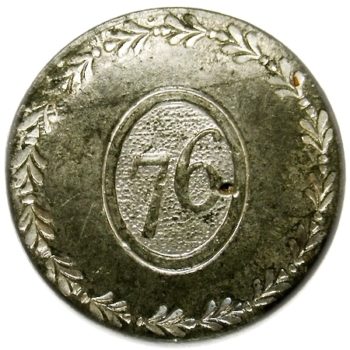
1777-1784 76th Regt. of Foot Mc Donnells Highlanders
Color: Silver With Gray Undertones.
Metal: Flat, Raised Numerals & Impressed Design, Silvered Copper.
Button Size: 21mm. Coat Size.
Present Condition: A Non Dug Specimen, Exceptional Planchet Condition, A Strong High Relief & Impressed Pattern Remains.
Robert’s Comments: The 76th Regt. of Foot was a Scottish Light Infantry regiment. They were raised in the west lands of Scotland and western isles under the commission of Colonel John MacDonnell of Lochgarry. This regiment was sometimes referred to as, “MacDonald’s Highlanders.” The regiment consisted of 7 Highland companies, 2 Lowlanders, and an Irish company. The regiment embarked for New York in 1779, and encamped in Brooklyn until 1780. In May of 1780, Sinclair the Earl of Caithness was badly wounded during the Siege of Charlestown, and the regiment continued to campaign but under the new command of Major Francis Needham, who was the 1st Earl of Kilmorey. The regiment fought at the Battle of the Green Spring in July of 1781, and was badly defeated by Gilbert du Motier and General Marquis Lafayette of the French Army. Three months later in October, the 76th was captured in the Siege of Yorktown. Following the end of the war in 1783, they returned to Scotland under the command of Robert Stuart. The regiment finally disbanded at Stirling Castle in March of 1784.
Reverse Button Analysis: This is a 1-piece w/ a raised boss and loop shank.
Picture Courteous of Ian Workman
1790’s-1812 Officer’s GR Button
Color: Silver With Black Highlights.
Metal: Flat, 1-Piece, Silver’d or Tinned.
Button Size: 16.71mm.
Cuff Size.
Present Condition: An Excavated Specimen, Strong Planchet Condition, A Strong Impression Remains.
Robert’s Notes: This is an Officer’s Cuff button to show loyalty directly to King George. Even though dug in Upstate NY region, it most likely was worn by a British Officer’s who fled to Canada after the American Revolution. This was definitely a high quality engraved “impressed”pattern which lends to early war time 1780’s before high relief designs.
Reverse Button Analysis: This is a one-piece button with a loop shank. The shank is original, straight, and intact.
Excavated in Upstate New York Lake George Vicinity.
The RJ Silverstein Collection.
